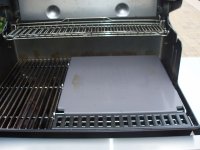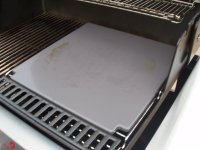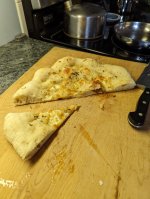Introduction
We recently bought a 2022 Genesis grill and have been using it for about a week. It replaced our much older Genesis grill. The Weber Crafted Frame Kit was included with the new grill. We ordered the Weber Crafted Pizza Stone (Weber part #7671) and also the Flat Top Griddle (#7672). Weber Crafted Accessories were created for their 2022 Genesis grills, but they also fit 2016 and up Genesis models with the purchase of the frame kit. Here are some helpful links to get you started:
https://www.weber.com/US/en/accesso...r-crafted/weber-crafted-pizza-stone/7671.html
https://tvwbb.com/threads/weber-cra...ection-new-accessories-system-for-2022.89801/
https://tvwbb.com/threads/weber-crafted-flat-top-griddle-first-look.91589/
Weber may have had difficulty settling on a name for the product. Some Weber sources call it "Weber Crafted Pizza Stone" and other Weber sources call it "Weber Crafted Glazed Baking Stone", while some sellers have come up with their own variations. I will call it "pizza stone." I hope I got that right when the dust settles. The pizza stone (and griddle) seem overpriced at $110 each (June 2022), but we hope they are "cry once, enjoy for a lifetime" items.
The primary reason we bought the Weber Crafted Pizza Stone is to move some of our baking outside during the hot summer months. The kitchen oven can throw a lot of heat into the house. Our electric oven costs much more to run between 4 and 9 PM in the summer, too. Our hope is that the pizza stone will yield pizzas that are close (closer?) to what we might get from a true pizza oven. I want to try baking bread on it too.
Pizza Stone Description
We have used ordinary (porous) baking stones in the kitchen oven for many years, but this is the first glazed baking stone we have owned. The glaze forms a hard, glassy surface over the top and sides of the pizza stone. It feels like a smooth ceramic floor tile. You cook your food on the glazed top. The back should always be face down. Aside from the glaze, the pizza stone is made from cordierite. Cordierite is a food safe, porous, clay-like material. Cordierite is a common material for baking stones. It does not expand or contract much over a wide temperature range, so it less likely to crack as you warm up the stone or put a pizza on the hot surface. The back of the Weber Crafted Pizza Stone looks and feels like a typical tan colored baking stone with a "Weber" imprint, but the glazed top is the cooking surface.
The pizza stone has two cutouts in the corners, which work well as finger holes for lifting it out.
Documentation is very limited, both in print and online. Weber includes an instruction sheet, but it is sparse. Weber instructs you to install the stone before heating the grill. There are a few bullet-style hints for cooking pizza, along with a few care and cleaning tips. The pizza hints (two for frozen, two for fresh) felt incomplete. We could not figure out if any of the hints applied to our pizza.
Frankly, it felt like "Here's your pizza stone. You figure it out." We realize that it is a new product, but would have liked more help from Weber regarding how to set the burners and temperatures for pizzas and other foods, etc. Hopefully Weber will backfill with more extensive "best practices" usage information along with recipes designed and tested for this pizza stone. (You can find lots of generic information on the internet about pizza on the grill, with or without baking stones. Most examples are on charcoal grills, not gas ones. Glazed baking stones are not discussed. There is nothing about using them on a grill.)
First Bake: Frozen Pizza
We decided to bake a cheap Walmart "rising crust" frozen pizza. I put the pizza stone on the grill while it was cool, before lighting the burners. I set the left burner on medium high, and the middle and right burners on low. I preheated the grill for 15 minutes while we prepared the pizza with little extra sauce, cheese, and toppings. The pizza was mostly frozen but somewhat thawed when we put it on the pizza stone. I kept the Weber thermometer in the lid between 400 and 450 F (~ 200-230 C).
The pizza was good, not great. The bottom of the crust was close to perfect, but the top of the dough was a little gummy. That was our fault. We like pizza with a lot of sauce and toppings, but it can interfere with how the pizza cooks and we know it. I don't have a photo of the pizza, but it looked normal, with a slightly darker, crispier crust. The next time we bake a frozen pizza, I will turn up the indirect left burner and put the center and right burners on fully low or leave them turned off entirely.
There was a small amount of baked-on oil or grease from the pizza. You can see it in the photos below. It was tar-like and tacky and did not wipe off with a damp paper towel. I sprinkled a small amount of baking soda on the spots and wet the paper towel. It came off with a small effort.
I will post an update or two as we learn more about using the pizza stone on our grill. The photos show the pizza stone after first use, a frozen pizza.


We recently bought a 2022 Genesis grill and have been using it for about a week. It replaced our much older Genesis grill. The Weber Crafted Frame Kit was included with the new grill. We ordered the Weber Crafted Pizza Stone (Weber part #7671) and also the Flat Top Griddle (#7672). Weber Crafted Accessories were created for their 2022 Genesis grills, but they also fit 2016 and up Genesis models with the purchase of the frame kit. Here are some helpful links to get you started:
https://www.weber.com/US/en/accesso...r-crafted/weber-crafted-pizza-stone/7671.html
https://tvwbb.com/threads/weber-cra...ection-new-accessories-system-for-2022.89801/
https://tvwbb.com/threads/weber-crafted-flat-top-griddle-first-look.91589/
Weber may have had difficulty settling on a name for the product. Some Weber sources call it "Weber Crafted Pizza Stone" and other Weber sources call it "Weber Crafted Glazed Baking Stone", while some sellers have come up with their own variations. I will call it "pizza stone." I hope I got that right when the dust settles. The pizza stone (and griddle) seem overpriced at $110 each (June 2022), but we hope they are "cry once, enjoy for a lifetime" items.
The primary reason we bought the Weber Crafted Pizza Stone is to move some of our baking outside during the hot summer months. The kitchen oven can throw a lot of heat into the house. Our electric oven costs much more to run between 4 and 9 PM in the summer, too. Our hope is that the pizza stone will yield pizzas that are close (closer?) to what we might get from a true pizza oven. I want to try baking bread on it too.
Pizza Stone Description
We have used ordinary (porous) baking stones in the kitchen oven for many years, but this is the first glazed baking stone we have owned. The glaze forms a hard, glassy surface over the top and sides of the pizza stone. It feels like a smooth ceramic floor tile. You cook your food on the glazed top. The back should always be face down. Aside from the glaze, the pizza stone is made from cordierite. Cordierite is a food safe, porous, clay-like material. Cordierite is a common material for baking stones. It does not expand or contract much over a wide temperature range, so it less likely to crack as you warm up the stone or put a pizza on the hot surface. The back of the Weber Crafted Pizza Stone looks and feels like a typical tan colored baking stone with a "Weber" imprint, but the glazed top is the cooking surface.
The pizza stone has two cutouts in the corners, which work well as finger holes for lifting it out.
Documentation is very limited, both in print and online. Weber includes an instruction sheet, but it is sparse. Weber instructs you to install the stone before heating the grill. There are a few bullet-style hints for cooking pizza, along with a few care and cleaning tips. The pizza hints (two for frozen, two for fresh) felt incomplete. We could not figure out if any of the hints applied to our pizza.
Frankly, it felt like "Here's your pizza stone. You figure it out." We realize that it is a new product, but would have liked more help from Weber regarding how to set the burners and temperatures for pizzas and other foods, etc. Hopefully Weber will backfill with more extensive "best practices" usage information along with recipes designed and tested for this pizza stone. (You can find lots of generic information on the internet about pizza on the grill, with or without baking stones. Most examples are on charcoal grills, not gas ones. Glazed baking stones are not discussed. There is nothing about using them on a grill.)
First Bake: Frozen Pizza
We decided to bake a cheap Walmart "rising crust" frozen pizza. I put the pizza stone on the grill while it was cool, before lighting the burners. I set the left burner on medium high, and the middle and right burners on low. I preheated the grill for 15 minutes while we prepared the pizza with little extra sauce, cheese, and toppings. The pizza was mostly frozen but somewhat thawed when we put it on the pizza stone. I kept the Weber thermometer in the lid between 400 and 450 F (~ 200-230 C).
The pizza was good, not great. The bottom of the crust was close to perfect, but the top of the dough was a little gummy. That was our fault. We like pizza with a lot of sauce and toppings, but it can interfere with how the pizza cooks and we know it. I don't have a photo of the pizza, but it looked normal, with a slightly darker, crispier crust. The next time we bake a frozen pizza, I will turn up the indirect left burner and put the center and right burners on fully low or leave them turned off entirely.
There was a small amount of baked-on oil or grease from the pizza. You can see it in the photos below. It was tar-like and tacky and did not wipe off with a damp paper towel. I sprinkled a small amount of baking soda on the spots and wet the paper towel. It came off with a small effort.
I will post an update or two as we learn more about using the pizza stone on our grill. The photos show the pizza stone after first use, a frozen pizza.


Last edited:



